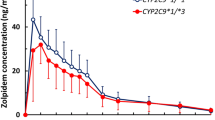Abstract
Aim
To study the pharmacokinetic characteristics of voriconazole in healthy Chinese male volunteers in relation to cytochrome P450 (CYP) 2C19 genotype status, including ultra-rapid metabolizers (URMs), homozygous extensive metabolizers (EMs), and poor metabolizers (PMs).
Method
Twenty healthy Chinese male volunteers were recruited for the study. Of these, four were CYP2C19 heterozygous URMs (*1/*17), eight were CYP2C19 homozygous EMs (*1/*1), and eight were CYP2C19 PMs (*2/*2). After a single oral dose of 200 mg voriconazole, plasma concentrations of voriconazole were determined for a 24-h period by liquid chromatography–mass spectrometry/mass spectrometry.
Result
In Chinese male subjects, the allele frequencies of the CYP2C19*17 and CYP2C19*2 alleles were 0.64 and 35.6%, respectively, and both alleles were in Hardy–Weinberg equilibrium. The area under the concentration–time curve (AUC) from predose to 24 h (AUC0–24) and from predose to infinity (AUC0-∞), and apparent oral clearance (CL/F) of voriconazole were statistically different among all three genotypic groups (P < 0.001, respectively). The maximum plasma concentration (Cmax) value of URMs also showed statistically significant differences from those of EMs and PMs (P = 0.036 and P = 0.035, respectively). The elimination half-life (t½) in URMs was 87% (P = 0.58) of that in EMs and 51% (P= 0.002) of that in PMs.
Conclusion
Our data indicate that the presence of the CYP2C19*17 allele results in ultra-rapid metabolism of voriconazole after a single oral dose.

Similar content being viewed by others
References
Theuretzbacher U, Ihle F, Derendorf H (2006) Pharmacokinetic/pharmacodynamic profile of voriconazole. Clin Pharmacokinet 45:649–663
Hyland R, Jones BC, Smith DA (2003) Identification of the cytochrome P450 enzymes involved in the N-oxidation of voriconazole. Drug Metab Dispos 31:540–547
Goldstein JA (2001) Clinical relevance of genetic polymorphisms in the human CYP2C subfamily. Br J Clin Pharmacol 52:349–355
Jacqz E, Dulac H, Mathieu H (1988) Phenotyping polymorphic drug metabolism in the French Caucasian population. Eur J Clin Pharmacol 35:167–171
Kubota T, Chiba K, Ishizaki T (1996) Genotyping of S-mephenytoin 4′-hydroxylation in an extended Japanese population. Clin Pharmacol Ther 60:661–666
Shu Y, Zhou HH (2000) Individual and ethnic differences in CYP2C19 activity in Chinese populations. Acta Pharmacol Sin 21:193–199
Sim SC, Risinger C, Dahl ML, Aklillu E, Christensen M, Bertilsson L et al (2006) A common novel CYP2C19 gene variant causes ultra-rapid drug metabolism relevant for the drug response to proton pump inhibitors and antidepressants. Clin Pharmacol Ther 79:103–113
Rengelshausen J, Banfield M, Riedel KD, Burhenne J, Weiss J, Thomsen T et al (2005) Opposite effects of short-term and long-term St John’s wort intake on voriconazole pharmacokinetics. Clin Pharmacol Ther 78:25–33
Wood N, Tan K, Purkins L, Layton G, Hamlin J, Kleinermans D et al (2003) Effect of omeprazole on the steady-state pharmacokinetics of voriconazole. Br J Clin Pharmacol 56[Suppl 1]:56–61
Ikeda Y, Umemura K, Kondo K, Sekiguchi K, Miyoshi S, Nakashima M (2004) Pharmacokinetics of voriconazole and cytochrome P450 2C19 genetic status. Clin Pharmacol Ther 75(6):587–588
He N, Yan F-X, Huang S-l, Wang W, Xiao Z-S, Liu Z-Q et al (2002) CYP2C19 genotype and S-mephentoin 4′-hydroxylation phenotype in a Chinese Dai population. Eur J Clin Pharmacol 58:15–18
Keevil BG, Newman S, Lockhart S, Howard SJ, Moore CB, Denning DW (2004) Validation of an assay for voriconazole in serum samples using liquid chromatography–tandem mass spectrometry. Ther Drug Monit 26:650–657
Vogeser M, Schiel X, Spöhrer U (2005) Quantification of voriconazole in plasma by liquid chromatography-tandem mass spectrometry. Clin Chem Lab Med 43(7):730–734
Purkins L, Wood N, Ghahramani P, Kleinermans D, Layton G, Nichols D (2003) No clinically significant effect of erythromycin or azithromycin on the pharmacokinetics of voriconazole in healthy male volunteers. Br J Clin Pharmacol 56[Suppl 1]:30–36
Mikus G, Schöwel V, Drzewinska M, Rengelshausen J, Ding R, Riedel KD et al (2006) Potent cytochrome P450 2C19 genotype-related interaction between voriconazole and the cytochrome P450 3A4 inhibitor ritonavir. Clin Pharmacol Ther 80:126–135
Geist MJ, Egerer G, Burhenne J, Burhenne J, Mikus G (2006) Safety of Voriconazole in a Patient with CYP2C9*2/CYP2C9*2 Genotype. Antimicrob Agents Chemother 50:3227–3228
Sugimoto K, Uno T, Yamazaki H, Tateishi T (2008) Limited frequency of the CYP2C19*17 allele and its minor role in a Janpanese population. Br J Clin Pharmacol 65(3):437–439
Dürr D, Stieger B, Kullak-Ublick GA, Rentsch KM, Steinert HC, Meier PJ et al (2000) St John’s wort induces intestinal P-glycoprotein/MDR1 and intestinal and hepatic CYP3A4. Clin Pharmacol Ther 68:598–604
Wang L-S, Zhu B, El-Aty AMA, Zhou G, Li Z, Wu J et al (2004) The influence of St. John’s wort on CYP2C19 activity with respect to genotype. J Clin Pharmacol 44:577–581
Wang L-S, Zhou G, Zhu B, Wu J, Wang J-G, El-Aty AMA et al (2004) St John’s wort induces both cytochrome P450 3A4-catalyzed sufoxidation and 2C19-dependent hydroxylation of omeprazole. Clin Pharmacol Ther 75:191–197
US Food and Drug Administration (2001). Briefing document for voriconazole. US Food and Drug Administration, Washington D.C. Available at: http://www.fda.gov/ohrms/dockets/ac/01/briefing/3792b2.htm
Pascual A, Calandra T, Bolay S, Buclin T, Bille J, Marchetti O (2008) Voriconazole therapeutic drug monitoring in patients with invasive mycoses improves efficacy and safety outcomes. Clin Infect Dis 46:201–111
Acknowledgments
This work was supported by the National Natural Scientific Foundation of China grants (No.30528026, 30300428, 30672497 and 30500623), by the China Medical Board of New York grants 01–755, and by the Postdoctoral Science Foundation of Central South University.
Author information
Authors and Affiliations
Corresponding author
Rights and permissions
About this article
Cite this article
Wang, G., Lei, HP., Li, Z. et al. The CYP2C19 ultra-rapid metabolizer genotype influences the pharmacokinetics of voriconazole in healthy male volunteers. Eur J Clin Pharmacol 65, 281–285 (2009). https://doi.org/10.1007/s00228-008-0574-7
Received:
Accepted:
Published:
Issue Date:
DOI: https://doi.org/10.1007/s00228-008-0574-7




